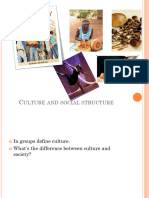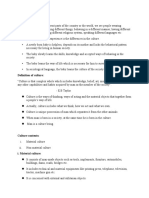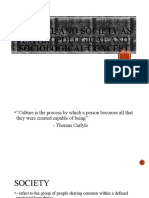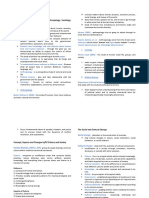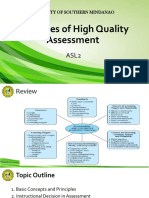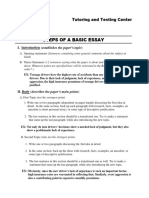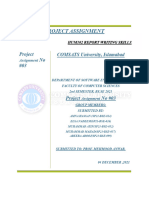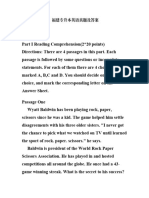Lecture I.
Introduction to the Course
___________________________________
Intercultural (Cross-Cultural) Communication
�Key-words
El
______________________________________________
Society
Culture
Cultural Diversity
Communication
Cross (Inter) - Cultural Communication (CCC)
�______________________________________________
I. Society
�Society
______________________________________________
Study of cultural diversity problems implies investigation of a
complex, multi-factor phenomenon. This investigation requires
considerable expenses and an adequate methodology.
Analysis of literature related to the issue demonstrates that the
greater is the number of factors and interrelations a researcher
takes in consideration the greater is a researchers confidence in
conclusion that the cultural diversity plays the decisive role.
Thus existence of social institutions and functions, social activities
and interaction among people, diversity of social statuses and
roles in a society suggests that the very society is diverse.
�Society
______________________________________________
1. Speaking about the society people often mean
not only national-state (social-historical) organism
but the whole system of such organisms (for
instance, West Europe or, with increasing frequency,
the EU or Arabic world and so on).
2. Society is connected with processes of
globalization and formation of network society and
network enterprises all over the contemporary world.
�Society
______________________________________________
Unity of territory, of economic life, commonality of
language (or availability of a language that serves
as a vehicle of communication, along with other
means of communication), commonality of social
norms, stereotypes and values make a stable
communication of groups etc. possible.
�Society
______________________________________________
The systemic principles of the society are:
Cohesiveness, wholeness (properties of the society cannot be reduced
to the sum of its components properties);
Structural nature (the society can be described through analysis of
relations and ties that exist among its components);
Interdependence of the society and its environment (the society forms
and expresses its properties in interaction with the environment);
Hierarchical nature (every element of the society is seen as a system in
respect of elements that constitute it and as a sub-system of the
society);
Functional character of the system and of its elements: the society and
every its element carry out strictly defined functions that are irreducible
to each other.
�Society
______________________________________________
Analyzing the social structure of society social
scientists examine norms and patterns of behavior,
views and beliefs, interests and life chances, typical
forms of communications that happen among
individuals who occupy various positions in the
social structure of a society and the extent of their
coherence.
�Society
______________________________________________
The traits of post-modern society (Z. Bauman):
Pluralism of cultures (it embraces absolutely
everything: traditions, ideologies, forms of life etc.);
Permanent and continual changes;
Lack of whatever universals of power;
Dominance of media and its products;
Absence of basic reality because everything, in the
last resort, is a symbol.
�______________________________________________
II. Cultural Diversity
�Society
______________________________________________
Globalization increases national and cultural diversity of the
present-day world and this diversity is the base of national
management models diversity. We are observing cultural and
national dierentiation of the society and this dierentiation
finds manifestations on inter-civilization, inter-confessional and
inter-ethnic conflicts.
Diversity as a category of sociology implies that the
cultural relativism, not absolute ethic norms or ideological
requirements is the most important for appraisal of human
acts.
There is a multitude of examples when diversity
(heterogeneity) prompted cultural and technological progress.
Diversity entails a number of negative consequences such as
disunity, alienation, inequality, national and religious conflict.
�Society
______________________________________________
The UNESCO Universal Declaration on
Cultural Diversity (2001)
consists of twenty sets of long-term objectives
(Main Lines of Action) to be achieved in order to
maintain, reinforce, enrich
and in many cases even reintroduce cultural
diversity in society at the local, national and
international levels
THE THREE Ds:
DIVERSITY, DIALOGUE, DEVELOPMENT
�Society
______________________________________________
The Member States commit themselves to taking appropriate steps to disseminate widely the
UNESCO Universal Declaration on Cultural Diversity and to encourage its effective application, in
particular by cooperating with a view to achieving the following objectives:
1.Deepening the international debate on questions relating to cultural diversity, particularly in
respect of its links with development and its impact on policy- making, at both national and
international level; taking forward notably consideration of the advisability of an international legal
instrument on cultural diversity.
2.Advancing in the definition of principles, standards and practices, on both the national and the
international levels, as well as of awareness-raising modalities and patterns of cooperation, that are
most conducive to the safeguarding and promotion of cultural diversity.
3.Fostering the exchange of knowledge and best practices in regard to cultural pluralism with a view
to facilitating, in diversified societies, the inclusion and participation of persons and groups from
varied cultural backgrounds.
4.Making further headway in understanding and clarifying the content of cultural rights as an integral
part of human rights.
5.Safeguarding the linguistic heritage of humanity and giving support to expression, creation and
dissemination in the greatest possible number of languages.
6.Encouraging linguistic diversity while respecting the mother tongue at all levels of education,
wherever possible, and fostering the learning of several languages from the earliest age.
7.Promoting through education an awareness of the positive value of cultural diversity and improving
to this end both curriculum design and teacher education.
8.Incorporating, where appropriate, traditional pedagogies into the education process with a view to
preserving and making full use of culturally appropriate methods of communication and transmission
of knowledge.
�______________________________________________
III. Culture
�Culture
______________________________________________
Culture comprises traditional ideas and related
values, and it is a product of actions (Kroeber and
Kluckhohn, 1952); it is learned, shared, and
transmitted from one generation to the next (Linton,
1945); and it organizes life and helps interpret
existence (Gordon, 1964).
Culture also is the way a people have learned to
respond to lifes problems.
�Culture
______________________________________________
Culture (Hall, 1977) - All countries have their own identity,
language, systems of nonverbal communication, material culture,
history and ways of doing things (p. 2).
Culture can be divide into two concepts (Moran, 2001):
1. Big C - the traditional, objective culture (for example, food,
theater, art, dance, or music).
2 Small c - the subjective culture. This has no existence except
in human behavior. Small c culture is an abstraction produced by
thought and can define characteristics such as body movement,
how we live, how we learn, how we work, and how we express
love, in response to similar events and experiences.
�Culture
______________________________________________
Culture can also be identified through three layers
(ONeil, 2006):
Cultural traditions that identify person as being part of
a particular society (for example, Russians).
Subculture. Here, complex societies can be labeled
even further as having a cultural tradition, within which
one may identify oneself as a part of that group with
further defining characteristics, such as Tatars in
Russia or Italian Americans in USA.
Human cultural traits.
�Culture
______________________________________________
These traits are shared among all cultures. Here are 12 examples of
such traits:
1. Communicating with a verbal language, using a limited set of sounds
and grammar rules;
2. Using a classification based on age and gender;
3. Classifying people based on marriage and relationships;
4. Raising children in a family-like situation;
5. A concept of privacy;
6. A sexual division of labor;
7. Rules that regulate sexual behavior;
8. A definition of good and bad behavior;
9. A definition of humor and playing games;
10. A definition of body adornment;
11. Art (part of the big C);
12. A kind of leadership role for deciding upon community issues
(ONeil, 2006).
�Culture
______________________________________________
Another definition of thinking of culture is to compare it to an onion
(Trompenaars Hampden-Turner, 2009). Here are three layers defined as
follows:
1. Outer Layer: Associated with the visual reality of behavior, clothes, food,
language, housing, and so forth. This is the level of explicit culture.
2. Middle Layer: Basically like the small c (something you cannot see), it
refers to the norms and values which a community holds; for example, what
is considered right and wrong (norms) or good and bad (values). Norms are
often external and reinforced by social control. Values tend to be more
internal than norms. Society doesn't have many means of controlling their
enforcement. These values and norms structure the way people in a
particular culture behave.
3. Inner Layer: This core consists of basic assumptions, a series of rules and
methods to deal with the regular problems that people face every day
unconsciously. These basic assumptions are automatic, like breathing. We
do it automatically and do not think about it.
�Culture
______________________________________________
Cultural paradigms define and dictate how human beings live and
experience life. Brown and Landrum-Brown (1995) describe the
dimensions along which cultures can differ.
Psychobehavioral modality refers to the mode of activity most
preferred within a culture. Do individuals actively engage their world
(doing), more passively experience it as a process (being), or
experience it with the intention of evolving (becoming)?
Axiology involves the interpersonal values that a culture teaches. Do
they compete or cooperate (competition vs. cooperation)? Are
emotions freely expressed or held back and controlled (emotional
restraint vs. emotional expressiveness)? Is verbal expression direct or
indirect (direct verbal expression vs. indirect verbal expression)? Do
group members seek help from others or do they keep problems
hidden so as not to shame their families (help seeking vs saving
face)?
�Culture
______________________________________________
Ethos refers to widely held beliefs within a cultural group that guide
social interactions. Are people viewed as independent beings or as
interdependent (independence vs. interdependence)? Is ones first
allegiance to oneself or to ones family (individual rights vs. honor and
protect family)? Are all individual group members seen as equal or is
there an acknowledged hierarchy of status or power (egalitarianism
vs. authoritarianism)? Are harmony, respect, and deference toward
others valued offer controlling and dominating them (control and
dominance vs. harmony and deference)?
Epistemology summarizes the preferred ways of gaining knowledge
and learning about the world. Do people rely more on their
intellectual abilities (cognitive process), their emotions and intuition
(affective processes, vibes, intuition), or a combination of both
(cognitive and affective)?
�Culture
______________________________________________
Logic involves the kind of reasoning process that group members adopt.
Are issues seen as being either one way or the other (either-or thinking)?
Can multiple possibilities be considered at the same time (both-and
thinking)? Or is thinking organized around inner consistency (circular)?
Ontology refers to how a culture views the nature of reality. Is what is real
only what can be seen and touched (objective material)? Is there level of
reality that exist beyond the material senses (subjective spiritual)? Or are
both levels of reality experienced (spiritual and material)?
Concept of time involves how time is experienced within a culture. Is it
clock-determined and linear (clock-based)? Is it defined in relation to
specific events (event-based)? Or is it experienced as repetitive (cyclical)?
Concept of self refers to whether group members experience themselves
separate beings (individual self) or as part of a greater collective (extended
self)?
�Culture
______________________________________________
Dimensions of Culture (Worldview Positions)
Worldview Dimensions
Sample worldview positions
Psychobehavioral modality axiology (values)
Doing vs. being vs. becoming
Competition vs. cooperation
Emotional restraint vs. emotional
expressiveness
Ethos (guiding beliefs)
Independence vs. interdependence
Individual rights vs. honor and protect family
Egalitarianism vs. authoritarianism
Control and dominance vs. harmony and
deference
Epistemology (how one knows)
Cognitive processes vs. affective processes
(vibes)
Intuition vs. cognitive and affective
Logic (reasoning process)
Either-or thinking vs. both-and thinking vs.
circular
Concept of time
Clock-based vs. event-based vs. cyclical
Concept of self
Individual self vs. extended self
Brown, M.T. & Landrum-Brown, J. (1995)
�______________________________________________
IV. Communication
�Communication
______________________________________________
Communication is one of the forms of human
activity, which is familiar to everyone.
Communication:
Direct conversation;
TV program;
Transmission of signals from the satellite to the
Earth;
Our external appearance, etc.
�Communication
______________________________________________
The concept of communication comes from the Latin
communicatio - sharing, communication,
conversation.
1. The concept is applied when it is necessary to
process information transmission, which includes
components such as the sender of the message
channels, content destination, efficiency, feedback and
others.
2. To describe an act of communication between people
by means of the symbol, the purpose of which is
understanding.
�Communication
______________________________________________
Types of Communication
Parameters of
Communication
Interpersonal
communication
Mass communication
Source of the Message
Family, neighbors - inner
circle
Institution
Distribution Channel
Face to face
Diffusion of technology
Time of Transmission
Direct
Direct / With a delay
Distance
Minimal, close
Vast
Receiver
Family, neighbors - inner
circle
Anonymous, diverse
audience
Feedback
Direct reaction of
recipient
Direct/indirect reaction
of recipient
Personal, individual
System of norms and
regulations
The Nature of
Regulation
�Communication
______________________________________________
Communication Process
(Shannon Weaver Model)
�______________________________________________
VI.
�CCC
______________________________________________
When we combine these three wordscross, culture, and
communicationinto one concept, we must define it as a very
complex term.
To live in a global world with intertwining cultures, we need to
understand why these communication messages are
interpreted differently. We need to know which messages are
positive ways of communicating and which are perceived as
negative.
CCC can be defined as an understanding and sharing of
meaning between people from different cultures in a verbal
and non-verbal context through interpersonal and masscommunication
�CCC
______________________________________________
Levels of Cultural Competence
Cultural Destructiveness
Cultural Incapacity
Cultural Blindness
Cultural Precompetence
Basic Cultural Competence
Cultural Proficiency
�The Management of Diversity in Societies
Post-Society (P. Sztompka)
Globalization
Cultural Diversity
New forms of risks, Inequality, Marginality, Social
Conflicts, Social Exclusion
Eective Cross-Cultural Communication
(Culture Proficiency)
Social Cohesion. Cultural and social progress.
�______________________________________________
V. Activities
�Activities
______________________________________________
1. Explore your culture. This exercise will help you
became more aware of your cultural roots and
identity. Answer the following questions* in relation to
each ethnic group that constitutes your culture of
origin. You might need to seek additional information
from parents or other relatives.
2. Take a cultural self-inventory. Review
Dimensions of culture. Ask yourself where you fit on
each dimension.
*standalone document
�______________________________________________
Thank you!

















